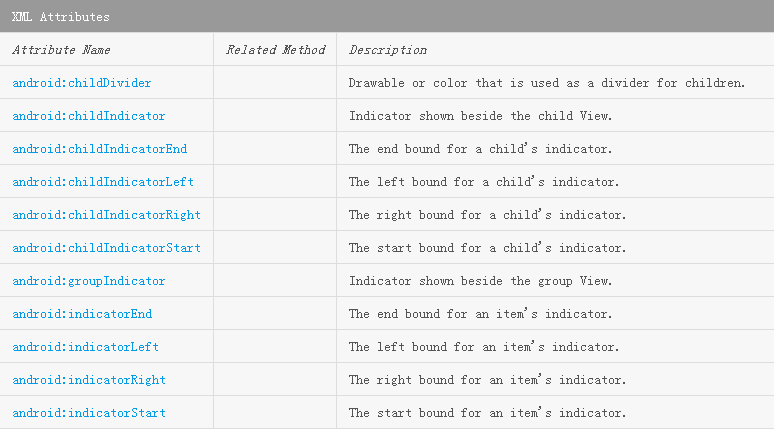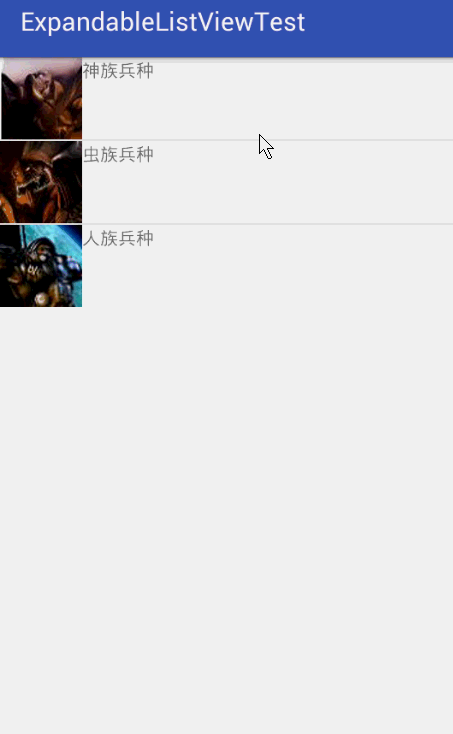ExpandableListView是ListView的子类,它在普通ListView的基础上进行了扩展,它把应用中的列表项分为几组,每组里又包含多个列表项。
ExpandableListView的用法与普通ListView的用法非常相似,只是ExpandableListView所显示的列表项应该由ExpandableListAdapter提供。ExpandableListView也是一个接口。
与Adapter类似的是,实现ExpandableListAdapter也有如下三种常用方式:
- 扩展BaseExpandableListAdapter,实现ExpandableListAdapter。
- 使用SimpleExpandableListAdapter将两个List集合包装成ExpandableListAdapter。
- 使用SimpleCursorTreeAdapter将Cursor中的数据包装成SimpleCursorTreeAdapter。
下图显示ExpandableListView额外支持的常用XML属性:
Demo:
布局文件:activity_main.xml
<?xml version="1.0" encoding="utf-8"?>
<LinearLayout xmlns:android="http://schemas.android.com/apk/res/android"
android:orientation="vertical"
android:layout_width="match_parent"
android:layout_height="match_parent">
<ExpandableListView
android:id="@+id/expandListView"
android:layout_width="match_parent"
android:layout_height="wrap_content"
/>
</LinearLayout>
主Activity:MainActivity.java
package com.example.expandablelistviewtest;
import android.support.v7.app.AppCompatActivity;
import android.os.Bundle;
import android.widget.ExpandableListView;
public class MainActivity extends AppCompatActivity {
@Override
protected void onCreate(Bundle savedInstanceState) {
super.onCreate(savedInstanceState);
setContentView(R.layout.activity_main);
ExpandableListView expandableListView = (ExpandableListView) findViewById(R.id.expandListView);
MainAdapter mainAdapter = new MainAdapter(this);
expandableListView.setAdapter(mainAdapter);
}
}
Adapter(扩展BaseExpandableListAdapter):MainAdapter.java
package com.example.expandablelistviewtest;
import android.content.Context;
import android.view.Gravity;
import android.view.View;
import android.view.ViewGroup;
import android.widget.AbsListView;
import android.widget.BaseExpandableListAdapter;
import android.widget.ImageView;
import android.widget.LinearLayout;
import android.widget.TextView;
/**
* Created by songxitang on 2015/12/1.
*/
public class MainAdapter extends BaseExpandableListAdapter {
private Context context;
int[] logos = new int[]
{
R.drawable.p,
R.drawable.z,
R.drawable.t
};
private String[] armTypes = new String[]
{"神族兵种", "虫族兵种", "人族兵种"};
private String[][] arms = new String[][]
{
{"狂战士", "龙骑士", "黑暗圣堂", "电兵"},
{"小狗", "刺蛇", "飞龙", "自爆飞机"},
{"机枪兵", "护士MM", "幽灵"}
};
public MainAdapter(Context context) {
this.context = context;
}
@Override
public int getGroupCount() {
return armTypes.length;
}
@Override
public int getChildrenCount(int groupPosition) {
return arms[groupPosition].length;
}
@Override
public Object getGroup(int groupPosition) {
return armTypes[groupPosition];
}
@Override
public Object getChild(int groupPosition, int childPosition) {
return arms[groupPosition][childPosition];
}
@Override
public long getGroupId(int groupPosition) {
return groupPosition;
}
@Override
public long getChildId(int groupPosition, int childPosition) {
return childPosition;
}
@Override
public boolean hasStableIds() {
return false;
}
@Override
public View getGroupView(int groupPosition, boolean isExpanded, View convertView, ViewGroup parent) {
//此处不建议用这种方式添加布局,最好使用布局文件添加布局。
LinearLayout linearLayout = new LinearLayout(context);
linearLayout.setOrientation(LinearLayout.HORIZONTAL);
ImageView imageView = new ImageView(context);
imageView.setImageResource(logos[groupPosition]);
TextView textView = new TextView(context);
textView.setText(getGroup(groupPosition).toString());
linearLayout.addView(imageView);
linearLayout.addView(textView);
return linearLayout;
}
private TextView getTextView()
{
AbsListView.LayoutParams layoutParams = new AbsListView.LayoutParams(
ViewGroup.LayoutParams.MATCH_PARENT,64);
TextView textView = new TextView(context);
textView.setLayoutParams(layoutParams);
textView.setGravity(Gravity.CENTER_VERTICAL|Gravity.LEFT);
textView.setPadding(36,0,0,0);
textView.setTextSize(20);
return textView;
}
@Override
public View getChildView(int groupPosition, int childPosition, boolean isLastChild, View convertView, ViewGroup parent) {
TextView textView = getTextView();
textView.setText(getChild(groupPosition,childPosition).toString());
return textView;
}
@Override
public boolean isChildSelectable(int groupPosition, int childPosition) {
return false;
}
}
运行效果:
上面程序使用扩展BaseExpandableListAdapter来实现ExpandableListAdapter,当扩展BaseExpandableListAdapter时,关键是实现如下4个方法:
- getGroupCount():该方法返回包含的组列表项的数量。
- getGroupView():该方法返回的View对象将作为组列表项。
- getChildrenCount():该方法返回特定组所包含的子列表项的数量。
- getChildView():该方法返回的View对象将作为特定组、特定位置的子列表项。
上面程序中的getChildView()方法返回一个普通TextView,因为每个自列表项都是一个普通文本框。而getGroupView()方法则返回一个LinearLayout对象,该LinearLayout对象里包含一个ImageView和一个TextView。因此,每个组列表项都由图片和文本组成。
参考自:《疯狂Android讲义》

























 322
322

 被折叠的 条评论
为什么被折叠?
被折叠的 条评论
为什么被折叠?










